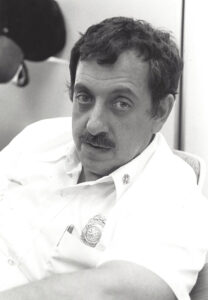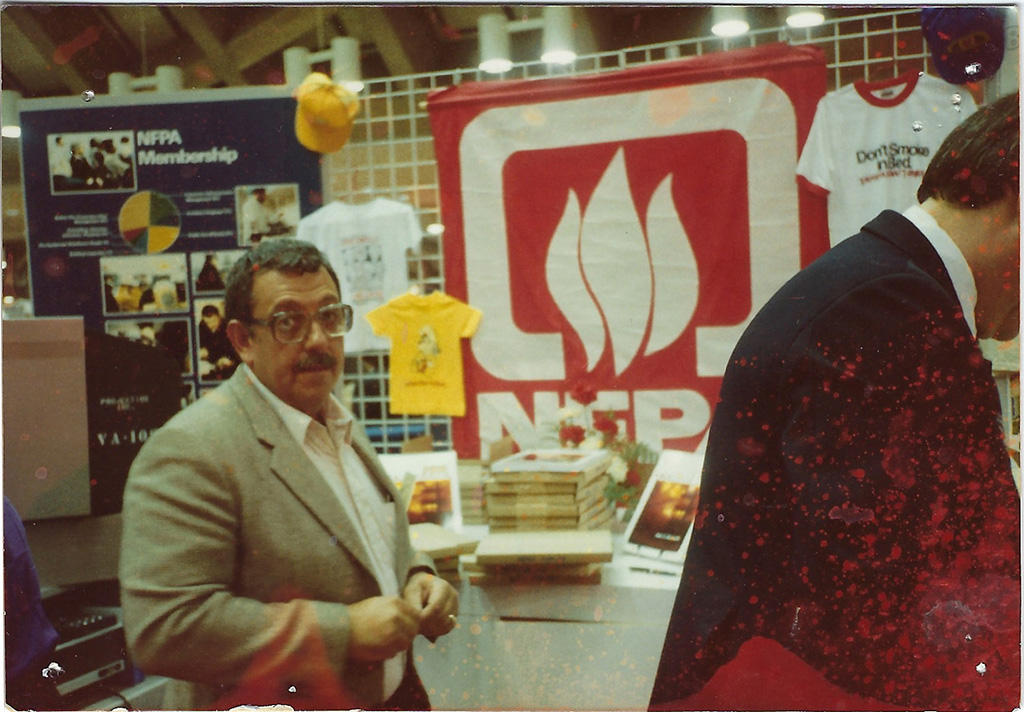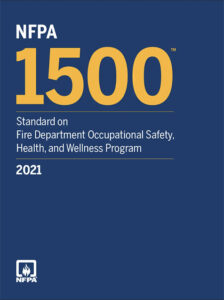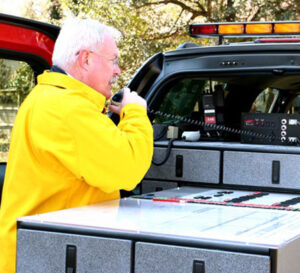So Others May Live: The Story of NFPA 1500
October 6, 2025So Others May Live:
The Story of NFPA 1500
Alan V. Brunacini & a team of like-minded visionaries spent years developing the standard credited with drastically reducing firefighter injuries & deaths.
By Murrey Loflin
B Shifter Buckslip, Oct. 7, 2025
Firefighting has long been recognized as the most hazardous occupation in North America in terms of occupational deaths and injuries. The statistics compiled annually by the National Fire Protection Association are more than sufficient evidence to demonstrate the need for increased efforts to reduce line-of-duty deaths, occupational injuries and illnesses.
The first edition of NFPA 1500: Standard on a Fire Service Occupational Safety and Health Program was issued by the NFPA Standards Council in 1987. Before it, there was no consensus standard for a fire service occupational safety and health program. Fire service organizations were increasingly subject to regulations developed for general industry. (OSHA uses the term “general industry” to refer to all industries not included in agriculture, construction or maritime jobs.) These standards, however, didn’t address many of the needs and concerns unique to emergency response organizations. Although LODDs were documented and reported, there remained a growing concern with the number of firefighters who suffered occupational injuries or developed occupational illnesses—often with debilitating or fatal consequences. The links between fire service work and respiratory illness and heart disease have been well established, and growing evidence shows similar connections to cancer and related diseases stemming from occupational exposure to carcinogens, toxic products of combustion and hazardous materials.
Development & Adoption

NFPA 1500 was initiated by Alan V. Brunacini, former Phoenix fire chief and chairman of the NFPA Board of Directors. Chief Brunacini had a crystal clear vision for improving firefighter safety and health, focusing not only on implementation but also on an overall cultural shift within the fire service. An excellent example of this was Chief Brunacini’s initiative to eliminate firefighters riding on the tailboard of fire apparatus and to require firefighters to ride in fully enclosed fire apparatus. Additionally, he recognized that the fire service was involved not only in firefighting operations, but also in an increasing range of responsibilities, including EMS, rescue services and hazmat response. These diverse activities exposed firefighters to myriad dangers, creating an even more complex set of occupational health issues. Additionally, there was a growing concern over the emotional and psychological consequences of providing emergency response.
Chief Brunacini enlisted the help of two dynamic, forward-thinking individuals: Bruce W. Teele, NFPA senior fire service safety specialist, and Richard M. Duffy, director of the International Association of Fire Fighters Division of Occupational Health and Safety. The first step in developing the new standard was to secure approval from the NFPA Standards Council.
In 1983, Chief Brunacini was appointed as the chairman of the NFPA Fire Service Occupational Safety and Health (FSOSH) Technical Committee. He then assembled a team to develop a standard that would outline minimum occupational health and safety requirements for the fire service. The first FSOSH Technical Committee was composed of 19 members and four alternates, including fire chiefs, company officers, firefighters, safety officers, career firefighter labor representatives, volunteer representatives, and various fire service equipment manufacturers.
In the 38 years since NFPA 1500’s creation, average annual firefighter LODDs have been slashed by nearly 40 percent, while the overall number of response calls has more than tripled.
Over the next four years, the FSOSH Technical Committee met throughout the United States to develop a draft document. Once the public input and comment meetings (now known as first draft and second draft meetings) were completed, NFPA 1500 was prepared by the technical committee and acted on by the NFPA at its annual meeting held May 18–21,1987, in Cincinnati. It was issued by the NFPA Standards Council on July 17, 1987, with an effective date of Aug. 7, 1987.
NFPA 1500 was divided into 10 chapters and 328 sections. The short list of basic requirements the publication mandated for firefighting organizations includes:
• Implementation of an occupational safety and health policy.
• Appointment of a fire department safety officer.
• Implementation of a training program to allow all fire department members to perform their assigned duties safely.
• Proper maintenance of all vehicles and protective clothing/equipment (PPE).
• Application of an incident management system for emergency operations.
• Development of health maintenance and member assistance programs for firefighters.
A key distinction between NFPA 1500 and previous safety manuals was the creation of a designated fire department health and safety officer. Unlike previous documents, NFPA 1500 called for a specific person to oversee and enforce the standard. The safety officer’s tasks include:
• Ensuring that applicable OSHA standards are met.
• Accident and injury reporting.
• Reviewing and approving the safety features of apparatus and PPE.
• Implementation and conducting safety training for the department.

Bruno’s leadership left a lasting mark on the fire service. During his tenure with the NFPA, he helped develop both NFPA 1500 and NFPA 1710, shaping the foundation of modern fire service safety and operations.
1500’s Far-Reaching Influence
NFPA 1500 established minimum fire service criteria in a variety of areas, including training, use of personal protective equipment, emergency operations, facility safety, apparatus safety, critical incident stress management, medical/physical requirements, and member fitness/wellness. Because it was written by a committee representing diverse interests from across the fire service, it also served as a gold standard for OSHA-related concerns.
The standard was designed for voluntary compliance, regardless of whether an authority having regulatory jurisdiction over a particular organization chose to adopt it as mandatory. The FSOSH Technical Committee developed NFPA 1500 to meet—or exceed—any existing mandatory or voluntary compliance standards addressing firefighter occupational safety and health.
Intended as an umbrella document, NFPA 1500 established the basic framework for a comprehensive safety and health program and outlined its implementation and management. A series of companion documents, providing specific details on specific aspects of firefighter occupational safety and health, was planned to further support it. These were: fire department safety officer (NFPA 1521), incident management system (NFPA 1561), infection control (NFPA 1581), comprehensive occupational medical program (NFPA 1582), health-related fitness program (NFPA 1583), and rehabilitation for members during emergency operations and training exercises (NFPA 1584).
 The document was revised in 1992, 1997, 2002, 2007, 2013, 2018 and 2021. Each new edition reflected input from the fire service and the technical committee. For example, the 2007 edition incorporated a comprehensive review based on NFPA and NIOSH data. It updated many sections to align with current best practices, reorganized certain requirements for ease of use, revised the risk-management section, and added additional explanations to the annex. The 2013 edition focused on updating references for consistency across NFPA documents, added new requirements for PPE training and use, and revised Chapters 11 and 12 concerning firefighter health, wellness and atypical stress exposure. Most importantly, this revision introduced the required use of the term mayday when a firefighter requires immediate assistance. The 2018 revision included several significant updates. The committee prohibited the approved use of external riding positions in wildland apparatus from Section 14.4 of NFPA 1906, Standard for Wildland Fire Apparatus, strengthened language prohibiting riding on any external section of an apparatus and required all occupants to utilize seatbelts. Furthermore, the committee added a section requiring ballistic protection for responders in high-risk incidents and reinforced unified command language. The 2021 edition incorporated the latest research on cleaning and decontaminating equipment and personnel, adding “preliminary exposure reduction” requirements that include science-based decontamination techniques.
The document was revised in 1992, 1997, 2002, 2007, 2013, 2018 and 2021. Each new edition reflected input from the fire service and the technical committee. For example, the 2007 edition incorporated a comprehensive review based on NFPA and NIOSH data. It updated many sections to align with current best practices, reorganized certain requirements for ease of use, revised the risk-management section, and added additional explanations to the annex. The 2013 edition focused on updating references for consistency across NFPA documents, added new requirements for PPE training and use, and revised Chapters 11 and 12 concerning firefighter health, wellness and atypical stress exposure. Most importantly, this revision introduced the required use of the term mayday when a firefighter requires immediate assistance. The 2018 revision included several significant updates. The committee prohibited the approved use of external riding positions in wildland apparatus from Section 14.4 of NFPA 1906, Standard for Wildland Fire Apparatus, strengthened language prohibiting riding on any external section of an apparatus and required all occupants to utilize seatbelts. Furthermore, the committee added a section requiring ballistic protection for responders in high-risk incidents and reinforced unified command language. The 2021 edition incorporated the latest research on cleaning and decontaminating equipment and personnel, adding “preliminary exposure reduction” requirements that include science-based decontamination techniques.
Consolidation Unifies Key Safety & Incident Management Standards
At its April 2019 meeting, the NFPA Standards Council reviewed and approved a consolidation plan for the Emergency Response & Responder Safety (ERRS) standards. Designed by ERRS stakeholders, the project focused on creating better efficiencies for the volunteer technical committee members who serve this audience. The consolidation effort pertained to most NFPA standards the ERRS team oversees, including various guides and recommended practices combined by topic. This process includes standards and guides addressing operational concerns, such as professional qualifications for responders; apparatus and vehicles; training, health, and wellness; and the care, selection, and maintenance of PPE.
As part of the ERRS Document Consolidation Plan, NFPA 1500 was merged into a new standard, NFPA 1550: Standard for Emergency Responder Health and Safety, which incorporates NFPA 1500, NFPA 1521: Standard for Fire Department Safety Officer Professional Qualifications and NFPA 1561: Standard on Emergency Services Incident Management System and Command Safety into a single document.
The 2024 version of NPFA 1550 contains 21 chapters and 22 annexes. It continues to provide enhanced guidance for managing a comprehensive fire department occupational safety and health program and specifies the necessary qualifications for a fire department safety officer. Additionally, its sections on the incident command system and command safety offer direction for managing Type IV and Type V incidents.
A Lifesaving Legacy
As NFPA 1500 was being developed, Chief Brunacini probably did not grasp what a profound effect it would have on firefighter safety, health and wellness for present and future generations of firefighters. Its impact has been dramatic. In the 38 years since NFPA 1500’s creation, average annual firefighter LODDs have been slashed by nearly 40 percent, while the overall number of response calls has more than tripled. Firefighter injuries are down about 30 percent. As a result of this document, turnout gear and PPE, apparatus and vehicles, procedures, incident command, fireground operations, and more have all been developed with firefighter safety in mind.

Murrey E. Loflin started his fire service career with the Beckley (W. Va.) Fire Department as a firefighter/EMT in June 1979. He was hired by the Virginia Beach (Va.) Fire Department in February 1983, as a firefighter/EMT. He held the ranks of captain and battalion chief. He was appointed the department’s first safety officer in 1986. He retired from the Virginia Beach Fire Department in August 2006. That September, Murrey was hired by West Virginia University Extension Services in Morgantown, W. Va., where he served as the director of Fire Service Extension and the director of the West Virginia State Fire Academy in Jackson’s Mill. In December 2010, Murrey accepted a position as investigator with the NIOSH Fire Fighter Fatality Investigation and Prevention Program located in Morgantown, W.Va. Murrey retired from the federal government in May 2025.



